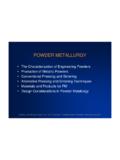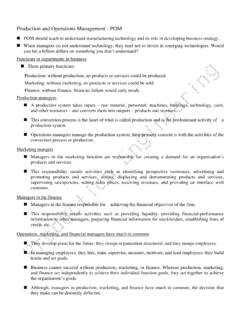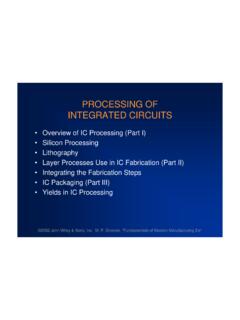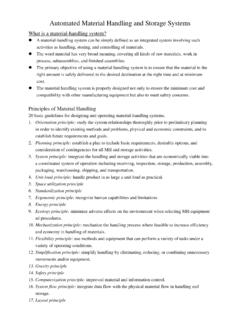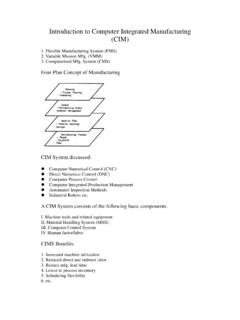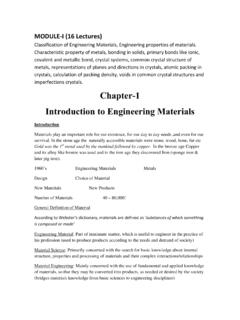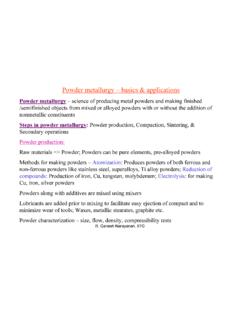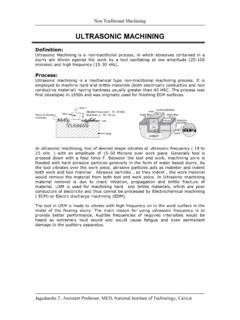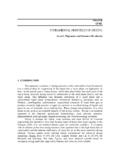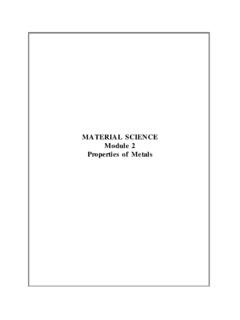Transcription of PHYSICAL PROPERTIES OF MATERIALS
1 2002 John Wiley & Sons, Inc. M. P. Groover, Fundamentals of Modern Manufacturing 2/e PHYSICAL PROPERTIESOF MATERIALS Volumetric and Melting PROPERTIES Thermal PROPERTIES Mass Diffusion Electrical PROPERTIES Electrochemical Processes 2002 John Wiley & Sons, Inc. M. P. Groover, Fundamentals of Modern Manufacturing 2/e PHYSICAL PROPERTIES DefinedProperties that define the behavior of MATERIALS inresponse to PHYSICAL forces other than mechanical Components in a product must do more than simplywithstand mechanical stresses They mustconduct electricity(or prevent conduction),allow heat to transfer(or allow its escape), transmitlight (or block transmission), and satisfy many otherfunctions Includes: volumetric, thermal, electrical, andelectrochemical PROPERTIES 2002 John Wiley & Sons, Inc.
2 M. P. Groover, Fundamentals of Modern Manufacturing 2/e PHYSICAL PROPERTIES in Manufacturing Important in manufacturing because they ofteninfluence process performance Examples: In machining,thermal propertiesof the workmaterial determine the cutting temperature, whichaffects how long tool can be used before failure Inmicroelectronics,electrical propertiesof siliconand how these PROPERTIES can be altered bychemical and PHYSICAL processes is the basis ofsemiconductor manufacturing 2002 John Wiley & Sons, Inc. M. P. Groover, Fundamentals of Modern Manufacturing 2/e Volumetric and Melting PropertiesProperties related to the volume of solids and how theproperties are affected by temperature Includes: Density Thermal expansion Melting point 2002 John Wiley & Sons, Inc. M. P. Groover, Fundamentals of Modern Manufacturing 2/e Density DefinedWeight per unit volume Typical units are g/cm3(lb/in3) Determined by atomic number and other factors suchas atomic radius, and atomic packingSpecific gravity= density of a material relative to densityof water and is a ratio with no units 2002 John Wiley & Sons, Inc.
3 M. P. Groover, Fundamentals of Modern Manufacturing 2/e Why Density is ImportantImportant consideration in material selection for a givenapplication, but it is generally not the only property ofinterest Strength is also important, and the two PROPERTIES areoften related in astrength-to-weight ratio, which istensile strength divided by its density Useful ratio in comparing MATERIALS for structuralapplications in aircraft, automobiles, and otherproducts where weight and energy are of concern 2002 John Wiley & Sons, Inc. M. P. Groover, Fundamentals of Modern Manufacturing 2/e Thermal Expansion Density of a material is a function of temperature In general, density decreases with increasingtemperature Volume per unit weight increases with increasingtemperature Thermal expansion is the name for this effect oftemperature on density Measured bycoefficient of thermal expansion 2002 John Wiley & Sons, Inc.
4 M. P. Groover, Fundamentals of Modern Manufacturing 2/e Coefficient of Thermal ExpansionChange in length per degree of temperature, such asmm/mm/ C (in/in/ F) Length ratio rather than volume ratio because this iseasier to measure and applyChange in length for a given temperature change is:L2-L1= L1(T2-T1)where = coefficient of thermal expansion;L1andL2are lengths corresponding respectively totemperaturesT1andT2 2002 John Wiley & Sons, Inc. M. P. Groover, Fundamentals of Modern Manufacturing 2/e Thermal Expansion in Manufacturing Thermal expansion is used inshrink fitandexpansion fitassemblies Part is heated to increase size or cooled todecrease size to permit insertion into another part When part returns to ambient temperature, atightly-fitted assembly is obtained Thermal expansion can be a problem inheattreatmentandweldingdue to thermal stresses thatdevelop in material during these processes 2002 John Wiley & Sons, Inc.
5 M. P. Groover, Fundamentals of Modern Manufacturing 2/e Melting Characteristics for ElementsMelting pointTmof a pure element = temperature atwhich it transforms from solid to liquid state The reverse transformation occurs at the sametemperature and is called thefreezing pointHeat of fusion= heat energy required atTmtoaccomplish transformation from solid to liquid 2002 John Wiley & Sons, Inc. M. P. Groover, Fundamentals of Modern Manufacturing 2/e Melting of Metal Alloys Unlike pure metals, most alloys do not have a singlemelting point Instead, melting begins at a temperature called thesolidusand continues as temperature increases untilconverting completely to liquid at a temperaturecalled theliquidus Between the two temperatures, the alloy is amixture of solid and molten metals Exception:eutectic alloysmelt (and freeze) at asingle temperature 2002 John Wiley & Sons, Inc.
6 M. P. Groover, Fundamentals of Modern Manufacturing 2/e Melting of Noncrystalline MATERIALS In noncrystalline MATERIALS (glasses), a gradualtransition from solid to liquid states occurs The solid material gradually softens as temperatureincreases, finally becoming liquid at the melting point During softening, the material has a consistency ofincreasing plasticity (increasingly like a fluid) as itgets closer to the melting point 2002 John Wiley & Sons, Inc. M. P. Groover, Fundamentals of Modern Manufacturing 2/e Figure in volume per unit weight (1/density) as afunction of temperature for a hypothetical pure metal, alloy, andglass; all exhibiting similar thermal expansion and meltingcharacteristics 2002 John Wiley & Sons, Inc. M. P. Groover, Fundamentals of Modern Manufacturing 2/e Importance of Meltingin Manufacturing Metal casting-the metal is melted and then pouredinto a mold cavity Metals with lower melting points are generallyeasier to cast Plastic molding-melting characteristics of polymersare important in nearly all polymer shaping processes Sintering of powdered metals-sintering does notmelt the material, but temperatures must approachthe melting point in order to achieve the requiredbonding of powders 2002 John Wiley & Sons, Inc.
7 M. P. Groover, Fundamentals of Modern Manufacturing 2/e Thermal PROPERTIES Thermal expansion, melting, and heat of fusion arethermal PROPERTIES because temperature determinesthe thermal energy level of the atoms, leading to thechanges in MATERIALS Additional thermal PROPERTIES : Specific heat Thermal conductivity These PROPERTIES relate to the storage and flow ofheat within a substance 2002 John Wiley & Sons, Inc. M. P. Groover, Fundamentals of Modern Manufacturing 2/e Specific HeatThe quantity of heat energy required to increase thetemperature of a unit mass of material by one degreeTo determine the energy to heat a certain weight ofmetal to a given elevated temperature:H=C W(T2-T1)whereH= amount of heat energy;C= specific heatof the material;W= its weight; and (T2-T1) = changein temperature 2002 John Wiley & Sons, Inc.
8 M. P. Groover, Fundamentals of Modern Manufacturing 2/e Volumetric Specific HeatThe quantity of heat energy required to raise thetemperature of a unit volume of material by onedegree Density multiplied by specific heatC Volumetric specific heat= C 2002 John Wiley & Sons, Inc. M. P. Groover, Fundamentals of Modern Manufacturing 2/e Thermal ConductivityThermal conduction-transfer of thermal energy within amaterial from molecule to molecule by purely thermalmotions; no transfer of massThermal conductivityof a material = capability totransfer heat through itself by this physicalmechanism Measured bycoefficient ofthermal : J/s mm C (Btu/in hr F) Coefficient of thermal conductivity is generally high inmetals, low in ceramics and plastics 2002 John Wiley & Sons, Inc. M. P. Groover, Fundamentals of Modern Manufacturing 2/e Thermal DiffusivityThe ratio of thermal conductivity to volumetric specificheat is frequently encountered in heat transferanalysisCkK 2002 John Wiley & Sons, Inc.
9 M. P. Groover, Fundamentals of Modern Manufacturing 2/e Thermal PROPERTIES in Manufacturing Important in manufacturing because heat generationis common in so many processes In some cases, heat is the energy thataccomplishes the process Examples: heat treating, sintering of powdermetals and ceramics In other cases, heat is generated as a result of theprocess Examples: cold forming and machining ofmetals 2002 John Wiley & Sons, Inc. M. P. Groover, Fundamentals of Modern Manufacturing 2/e Mass DiffusionMovement of atoms or molecules within a material oracross a boundary between two MATERIALS in contact Because of thermal agitation of the atoms in amaterial (solid, liquid, or gas), atoms are continuouslymoving about In liquids and gases, where the level of thermalagitation is high, it is a free-roaming movement In metals, atomic motion is facilitated by vacanciesand other imperfections in the crystal structure 2002 John Wiley & Sons, Inc.
10 M. P. Groover, Fundamentals of Modern Manufacturing 2/e Figure diffusion: (a) model of atoms in two solid blocksin contact: (1) when two pieces are first brought together, eachhas its own compositions; (2) after time, an exchange of atomsoccurs; and (3) eventually, a uniform concentration occurs. Theconcentration gradientdc/dxfor metal A is plotted in (b). 2002 John Wiley & Sons, Inc. M. P. Groover, Fundamentals of Modern Manufacturing 2/e Mass Diffusion in Manufacturing Surface hardening treatments based on diffusionincludecarburizingandnitriding Diffusion welding-used to join two components bypressing them together and allowing diffusion tooccur across boundary to create a permanent bond Diffusion is also used inelectronics manufacturingtoalter the surface chemistry of a semiconductor chip invery localized regions to create circuit details 2002 John Wiley & Sons, Inc.

